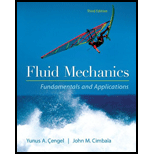
The rate of fuel burn.
The exit temperature of air.
Answer to Problem 95P
The rate of fuel burn is
The exit temperature of air is
Explanation of Solution
Given information:
The diameter of combustion chamber is
Write the expression for inlet cross- section area of combustion chamber.
Here, diameter of combustion chamber is
Write the expression for inlet density of air.
Here, pressure at inlet is
Write the expression for inlet mass flow rate.
Here, velocity at inlet is
Write the expression for stagnation temperature.
Here, initial temperature is
Write the expression for Mach number at inlet.
Here, specific heat ratio is
Write the expression for heat transfer.
Here, stagnation temperature at inlet is
Write the expression for mass flow rate.
Here, heating value is
Calculation:
Substitute
Refer to Table-A-1 “Molar mass, gas constant, and ideal gas specific heat of some substances” to obtain gas constant of air as
Substitute
Substitute
Substitute
Substitute
Refer to Table-A-15 “Rayleigh flow function for an ideal gas with
Write the relation of temperature at initial stagnation state and sonic state.
Here, temperature inlet sonic state is
Write the relation of velocity at initial stagnation state and sonic state.
Here, inlet velocity at sonic state is
Refer to Table-A-15 “Rayleigh flow function for an ideal gas with
Write the relation of temperature at initial stagnation state and sonic state.
Here, temperature inlet sonic state is
Write the relation of velocity at initial stagnation state and sonic state.
Here, inlet velocity at sonic state is
Substitute
Substitute
Substitute
Substitute
Substitute
Substitute
Substitute
Conclusion:
The rate of fuel burn is
The exit temperature of air is
Want to see more full solutions like this?
Chapter 12 Solutions
Fluid Mechanics Fundamentals And Applications
- My ID#016948724 please solve this problems and show me every step clear to follow pleasearrow_forwardMy ID# 016948724arrow_forwardPlease do not use any AI tools to solve this question. I need a fully manual, step-by-step solution with clear explanations, as if it were done by a human tutor. No AI-generated responses, please.arrow_forward
- Please do not use any AI tools to solve this question. I need a fully manual, step-by-step solution with clear explanations, as if it were done by a human tutor. No AI-generated responses, please.arrow_forwardPlease do not use any AI tools to solve this question. I need a fully manual, step-by-step solution with clear explanations, as if it were done by a human tutor. No AI-generated responses, please.arrow_forward[Q2]: The cost information supplied by the cost accountant is as follows:Sales 20,00 units, $ 10 per unitCalculate the (a/ newsale guantity and (b) new selling price to earn the sameVariable cost $ 6 per unit, Fixed Cost $ 30,000, Profit $ 50,000profit ifi) Variable cost increases by $ 2 per unitil) Fixed cost increase by $ 10,000Ili) Variable cost increase by $ 1 per unit and fixed cost reduces by $ 10,000arrow_forward
- can you please help me perform Visual Inspection and Fractography of the attatched image: Preliminary examination to identify the fracture origin, suspected fatigue striation, and corrosion evidences.arrow_forwardcan you please help[ me conduct Causal Analysis (FTA) on the scenario attatched: FTA diagram which is a fault tree analysis diagram will be used to gain an overview of the entire path of failure from root cause to the top event (i.e., the swing’s detachment) and to identify interactions between misuse, material decay and inspection errors.arrow_forwardhi can you please help me in finding the stress intensity factor using a k-calcluator for the scenario attathced in the images.arrow_forward
 Elements Of ElectromagneticsMechanical EngineeringISBN:9780190698614Author:Sadiku, Matthew N. O.Publisher:Oxford University Press
Elements Of ElectromagneticsMechanical EngineeringISBN:9780190698614Author:Sadiku, Matthew N. O.Publisher:Oxford University Press Mechanics of Materials (10th Edition)Mechanical EngineeringISBN:9780134319650Author:Russell C. HibbelerPublisher:PEARSON
Mechanics of Materials (10th Edition)Mechanical EngineeringISBN:9780134319650Author:Russell C. HibbelerPublisher:PEARSON Thermodynamics: An Engineering ApproachMechanical EngineeringISBN:9781259822674Author:Yunus A. Cengel Dr., Michael A. BolesPublisher:McGraw-Hill Education
Thermodynamics: An Engineering ApproachMechanical EngineeringISBN:9781259822674Author:Yunus A. Cengel Dr., Michael A. BolesPublisher:McGraw-Hill Education Control Systems EngineeringMechanical EngineeringISBN:9781118170519Author:Norman S. NisePublisher:WILEY
Control Systems EngineeringMechanical EngineeringISBN:9781118170519Author:Norman S. NisePublisher:WILEY Mechanics of Materials (MindTap Course List)Mechanical EngineeringISBN:9781337093347Author:Barry J. Goodno, James M. GerePublisher:Cengage Learning
Mechanics of Materials (MindTap Course List)Mechanical EngineeringISBN:9781337093347Author:Barry J. Goodno, James M. GerePublisher:Cengage Learning Engineering Mechanics: StaticsMechanical EngineeringISBN:9781118807330Author:James L. Meriam, L. G. Kraige, J. N. BoltonPublisher:WILEY
Engineering Mechanics: StaticsMechanical EngineeringISBN:9781118807330Author:James L. Meriam, L. G. Kraige, J. N. BoltonPublisher:WILEY





